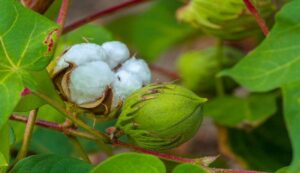Indian farmers should cultivate these top 5 varieties of cotton; there will be more yield
Cotton Cultivation: One of India’s unique agricultural products is cotton. India is the world’s second-largest producer of cotton. Naturally occurring fibers are produced from cotton, a cash crop. Let us inform you that cotton farming is crucial to the nation’s agricultural and industrial sectors. The term “white gold” is often used by farmers to describe cotton. The first week of June marks the beginning of the Kharij season, when farmers begin planting. Both irrigated and non-irrigated soils are used for its cultivation. If farmers plant superior types of cotton, they may quadruple their revenue.

Learn about Better Varieties of Cotton and how to grow it
Growing Cotton
May and June are when cotton is planted. For its cultivation to provide excellent results, a suitable environment is necessary. 16 degrees Celsius is said to be ideal for growing it, whereas 32 to 34 degrees Celsius are thought to be ideal for germination. Cotton is said to grow well on sandy and sandy loam soil because it retains enough water and drains well. The pH of the soil should be between 5.5 and 6.0 for its cultivation. In northern India, irrigation is essential to the production of cotton. Farmers should plow their fields one or two times, then lightly plough them three or four times before leveling the fields and planting cotton.
Top Five Varieties of Cotton
1. Supercott Variety BGII 115
Supercott BGII 115 is regarded as one of the best cotton varieties. Farmers may grow this cotton cultivar in both irrigated and non-irrigated settings since it is thought to be resistant to sucking insects. Medium and thick soils are suitable for the easy sowing of this kind of cotton. The cotton crop is ready about 160–170 days after it is sown. By growing this kind of cotton, farmers may produce around 20 to 25 quintals per acre.
2. The Rasi RCH 773 Type
You may see the Rasi RCH 773 variety’s fully green plants. This kind of cotton can withstand insects that feed on its juice. A yield of 20 to 22 quintals may be obtained by farmers who grow this cultivar on an acre. Both irrigated and non-irrigated regions may support its cultivation. Both light and medium land are thought to be appropriate for this cotton cultivar.
3. The Indo-US 936 BGII Type
An acre of land yields 15 to 20 quintals of output for farmers that grow the Indo-US 936 BGII type. Additionally, this cotton species can withstand sucking insects. This kind of cotton may be planted by farmers in both irrigated and non-irrigated environments. Light to medium-sized land is suitable for its cultivation. The crop takes 155 to 160 days to mature after seeding.
4. BG II variety Ajit 199
One of the greatest cotton cultivars is the Ajit 199 BG II variety. Cotton of this kind can withstand sucking insects. The Ajit 199 BG II cultivar may be grown by farmers in both irrigated and non-irrigated locations. The crop takes 145 to 160 days to mature after seeding. A yield of 22 to 25 quintals of cotton may be obtained by farmers who grow this type on an acre of land.
5. The MRC 7361 Variety of Mahyco Bahubali
The Mahyco Bahubali MRC 7361 cultivar ripens in a moderate amount of time. This type may be grown by farmers in both irrigated and non-irrigated locations. This cotton type has bolls that are single in size and have a decent weight. Cotton of this kind can withstand sucking insects. This variety’s bolls are connected close to the branches and have a nice opening. A yield of 20 to 25 quintals of cotton may be obtained by farmers who grow this type on an acre.

